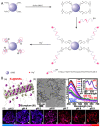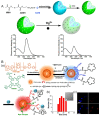Nanomaterial-Based Dual-Emission Ratiometric Fluorescent Sensors for Biosensing and Cell Imaging
- PMID: 34372142
- PMCID: PMC8348892
- DOI: 10.3390/polym13152540
Nanomaterial-Based Dual-Emission Ratiometric Fluorescent Sensors for Biosensing and Cell Imaging
Abstract
Owing to the unique optophysical properties of nanomaterials and their self-calibration characteristics, nanomaterial-based (e.g., polymer dots (Pdots) quantum dots (QDs), silicon nanorods (SiNRs), and gold nanoparticle (AuNPs), etc.) ratiometric fluorescent sensors play an essential role in numerous biosensing and cell imaging applications. The dual-emission ratiometric fluorescence technique has the function of effective internal referencing, thereby avoiding the influence of various analyte-independent confounding factors. The sensitivity and precision of the detection can therefore be greatly improved. In this review, the recent progress in nanomaterial-based dual-emission ratiometric fluorescent biosensors is systematically summarized. First, we introduce two general design approaches for dual-emission ratiometric fluorescent sensors, involving ratiometric fluorescence with changes of one response signal and two reversible signals. Then, some recent typical examples of nanomaterial-based dual-emission ratiometric fluorescent biosensors are illustrated in detail. Finally, probable challenges and future outlooks for dual-emission ratiometric fluorescent nanosensors for biosensing and cell imaging are rationally discussed.
Keywords: biosensing; cell imaging; nanomaterial; ratiometric fluorescent sensor.
Conflict of interest statement
The authors declare no conflict of interest.
Figures






Similar articles
-
Ratiometric fluorescence, electrochemiluminescence, and photoelectrochemical chemo/biosensing based on semiconductor quantum dots.Nanoscale. 2016 Apr 28;8(16):8427-42. doi: 10.1039/c6nr01912a. Epub 2016 Apr 8. Nanoscale. 2016. PMID: 27056088 Review.
-
Ratiometric fluorescent nanoprobes for visual detection: Design principles and recent advances - A review.Anal Chim Acta. 2019 Nov 4;1079:30-58. doi: 10.1016/j.aca.2019.06.035. Epub 2019 Jun 17. Anal Chim Acta. 2019. PMID: 31387719 Review.
-
Visualizing BPA by molecularly imprinted ratiometric fluorescence sensor based on dual emission nanoparticles.Biosens Bioelectron. 2017 Jun 15;92:147-153. doi: 10.1016/j.bios.2017.02.013. Epub 2017 Feb 11. Biosens Bioelectron. 2017. PMID: 28213327
-
Cu-Mn codoped ZnS quantum dots-based ratiometric fluorescent sensor for folic acid.Anal Chim Acta. 2018 Dec 21;1040:136-142. doi: 10.1016/j.aca.2018.08.010. Epub 2018 Aug 10. Anal Chim Acta. 2018. PMID: 30327103
-
Gold nanocluster-based fluorescent sensors for in vitro and in vivo ratiometric imaging of biomolecules.Phys Chem Chem Phys. 2023 Aug 23;25(33):21787-21801. doi: 10.1039/d3cp02714g. Phys Chem Chem Phys. 2023. PMID: 37577965 Review.
Cited by
-
Towards the Use of Individual Fluorescent Nanoparticles as Ratiometric Sensors: Spectral Robustness of Ultrabright Nanoporous Silica Nanoparticles.Sensors (Basel). 2023 Mar 26;23(7):3471. doi: 10.3390/s23073471. Sensors (Basel). 2023. PMID: 37050530 Free PMC article.
-
Ratiometric optical probes for biosensing.Theranostics. 2023 Apr 29;13(8):2632-2656. doi: 10.7150/thno.82323. eCollection 2023. Theranostics. 2023. PMID: 37215562 Free PMC article. Review.
-
Intravital Microscopy Reveals Endothelial Transcytosis Contributing to Significant Tumor Accumulation of Albumin Nanoparticles.Pharmaceutics. 2023 Feb 3;15(2):519. doi: 10.3390/pharmaceutics15020519. Pharmaceutics. 2023. PMID: 36839841 Free PMC article.
-
Dual-Color Fluorescent Hydrogel Microspheres Combined with Smartphones for Visual Detection of Lactate.Biosensors (Basel). 2022 Sep 28;12(10):802. doi: 10.3390/bios12100802. Biosensors (Basel). 2022. PMID: 36290939 Free PMC article.
-
Development of a Pyrone-Fused Tricyclic Scaffold-based Ratiometric Fluorescent Probe for Al3+ Detection.J Fluoresc. 2025 Jun;35(6):4559-4568. doi: 10.1007/s10895-024-03864-w. Epub 2024 Jul 23. J Fluoresc. 2025. PMID: 39042359
References
-
- Gui R.J., Jin H., Bu X.N., Fu Y.X., Wang Z.H., Liu Q.Y. Recent advances in dual-emission ratiometric fluorescence probes for chemo/biosensing and bioimaging of biomarkers. Coordin. Chem. Rev. 2019;383:82–103. doi: 10.1016/j.ccr.2019.01.004. - DOI
-
- Bigdeli A., Ghasemi F., Abbasi-Moayed S., Shahrajabian M., Fahimi-Kashani N., Jafarinejad S., Farahmand Nejad M.A., Hormozi-Nezhad M.R. Ratiometric fluorescent nanoprobes for visual detection: Design principles and recent advances—A review. Anal. Chim. Acta. 2019;1079:30–58. doi: 10.1016/j.aca.2019.06.035. - DOI - PubMed
Publication types
Grants and funding
LinkOut - more resources
Full Text Sources

